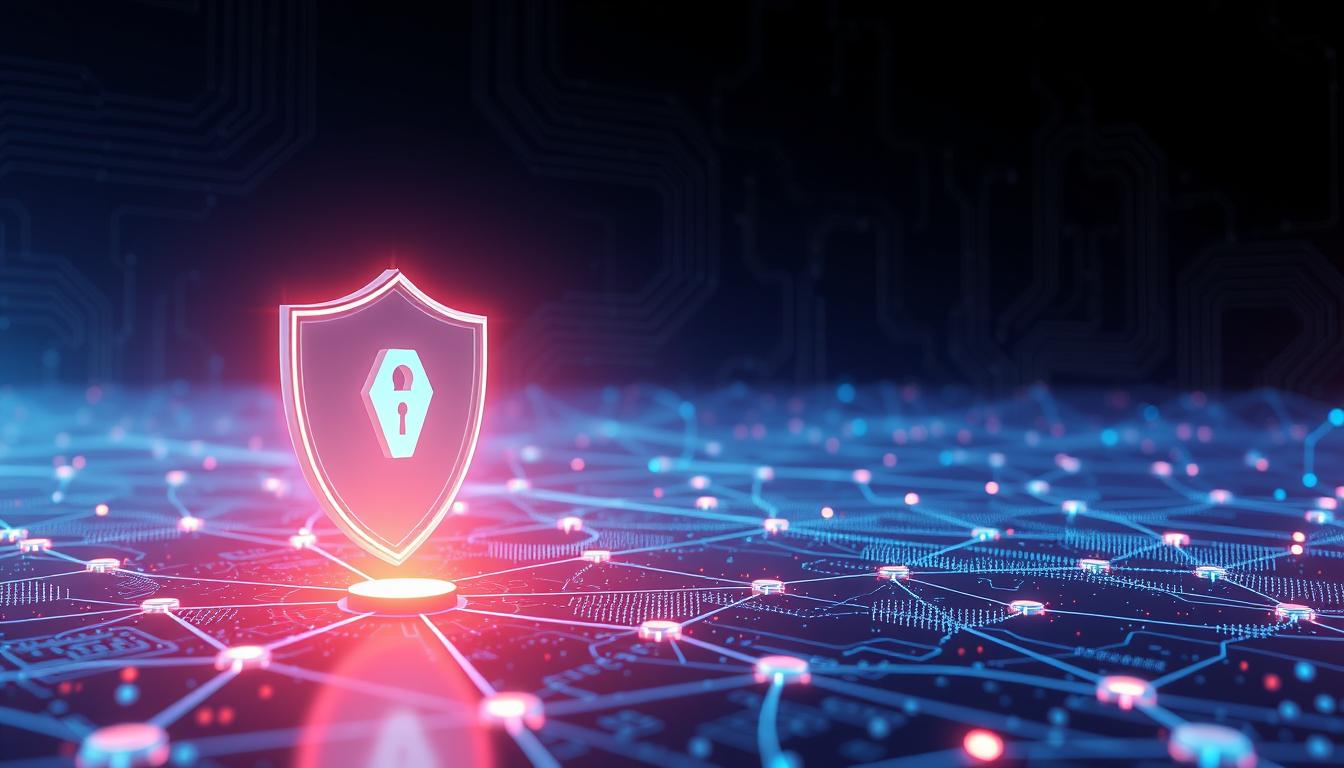Did you know that global spending on security monitoring solutions is expected to surpass $29 billion by 2025? This staggering figure underscores the critical importance of effective security monitoring in today’s digital landscape. Security monitoring is a proactive approach to safeguarding your digital assets, personal information, and business operations from a growing array of cybersecurity threats.
By implementing robust security monitoring strategies, individuals and organizations can enhance their overall safety, protect their valuable data, and ensure business continuity in the face of evolving security challenges. This article will explore the significance of security monitoring, the different types of monitoring solutions, and best practices for implementing a comprehensive security monitoring strategy.
Key Takeaways
- Security monitoring is essential for proactive threat detection and prevention, ensuring the safety of your digital assets.
- Effective security monitoring can help organizations maintain compliance, manage risk, and enhance their overall security posture.
- Different types of security monitoring, such as network monitoring and vulnerability scanning, provide comprehensive coverage against a range of cyber threats.
- Implementing a well-designed security monitoring strategy, coupled with best practices like continuous monitoring and incident response planning, is crucial for protecting your data and operations.
- By leveraging security monitoring solutions, individuals and businesses can take a proactive approach to safeguarding their digital environments and maintaining business continuity.
The Importance of Security Monitoring
In today’s digital landscape, security monitoring has become a critical component of organizational risk management. By continuously monitoring network activity, security professionals can proactively detect and mitigate potential security threats, ensuring the safety and integrity of sensitive data.
Proactive Threat Detection
Effective security monitoring enables organizations to identify anomalies, suspicious behavior, and known attack patterns in real-time. This allows security teams to respond quickly and effectively, reducing the risk of successful cyber attacks and minimizing the potential impact on business operations.
Compliance and Risk Management
Maintaining regulatory compliance is a major concern for many organizations. Security monitoring plays a crucial role in this process, helping organizations track and document their security practices to demonstrate adherence to industry standards and regulations. Additionally, by identifying and addressing vulnerabilities, security monitoring enhances an organization’s overall risk assessment and management capabilities.
“Proactive security monitoring is the cornerstone of a robust cybersecurity strategy. It empowers organizations to stay one step ahead of evolving threats and protect their most valuable assets.”
Investing in comprehensive security monitoring solutions is a strategic decision that can have far-reaching benefits for organizations of all sizes and industries. By prioritizing this critical aspect of cybersecurity, businesses can enhance their overall resilience and safeguard their operations against the ever-changing landscape of digital threats.
Types of Security Monitoring
Protecting your organization’s digital assets requires a comprehensive security monitoring strategy that encompasses a variety of tools and techniques. Two key components of an effective security monitoring approach are network monitoring and vulnerability scanning.
Network Monitoring
Network monitoring involves closely observing your organization’s network traffic, device connectivity, and system performance to identify any unauthorized access or unusual activity. By constantly monitoring your network, you can rapidly detect and address potential threats, such as unauthorized access attempts, data breaches, or system malfunctions. This proactive approach to network monitoring helps strengthen your intrusion prevention efforts and ensures the ongoing data protection of your critical systems and information.
Vulnerability Scanning
Complementing your network monitoring efforts, vulnerability scanning is a crucial tool for identifying potential weaknesses in your systems and applications. By regularly scanning your infrastructure, you can uncover vulnerabilities that could be exploited by cyber attackers, allowing you to prioritize and address these issues before they can be exploited. This comprehensive approach to vulnerability scanning is an essential part of your overall security monitoring strategy, empowering you to proactively mitigate risks and maintain a robust security posture.
| Feature | Network Monitoring | Vulnerability Scanning |
|---|---|---|
| Purpose | Detect unauthorized access and unusual activity | Identify potential system and application weaknesses |
| Key Benefits |
|
|
| Frequency | Continuous monitoring | Regular scanning (e.g., weekly, monthly) |
By leveraging a combination of network monitoring and vulnerability scanning, organizations can build a robust and proactive security monitoring framework that helps them stay ahead of evolving threats and maintain the integrity of their critical systems and data.
Implementing a Security Monitoring Strategy
Establishing an effective security monitoring strategy is crucial for safeguarding your organization’s digital assets and ensuring compliance. This comprehensive approach involves assessing your security posture, integrating multiple security tools, and training employees on best practices. By taking a holistic view, you can create a layered security system that proactively detects and responds to potential threats.
The first step in implementing a security monitoring strategy is to conduct a thorough risk assessment. This involves identifying the sensitive data and critical systems that require the highest level of protection, as well as the potential vulnerabilities and threats that could compromise your security. Once you have a clear understanding of your organization’s risk profile, you can develop tailored policies and procedures to address these concerns.
Next, you’ll need to integrate a suite of security monitoring tools and technologies that work together to provide a comprehensive view of your security landscape. This may include network monitoring solutions, vulnerability scanning tools, and incident response platforms. By consolidating data from these various sources, you can gain a deeper understanding of your security posture and quickly respond to any detected anomalies or security incidents.
Finally, it’s essential to train your employees on the importance of security monitoring and their role in maintaining a robust security posture. This includes educating them on access control protocols, data protection best practices, and incident response procedures. By empowering your team to be vigilant and proactive, you can create a culture of security awareness that strengthens the overall effectiveness of your security monitoring strategy.
Implementing a comprehensive security monitoring strategy is not a one-time effort, but rather an ongoing process of continuous improvement. By regularly reviewing and updating your policies, integrating the latest security technologies, and fostering a security-conscious workforce, you can ensure that your organization remains resilient in the face of evolving cyber threats.
“Effective security monitoring is the foundation of a robust cybersecurity program. It allows organizations to proactively detect, respond, and mitigate security risks, safeguarding their most valuable assets.”
Security Monitoring Best Practices
Maintaining robust security in today’s digital landscape requires a proactive approach. To ensure the effectiveness of your security monitoring efforts, it’s crucial to embrace a set of best practices. Two key areas to focus on are continuous monitoring and incident response planning.
Continuous Monitoring
Continuous monitoring is the backbone of effective security monitoring. By analyzing security data in real-time, organizations can swiftly identify and address emerging threats before they can cause significant damage. This approach involves:
- Leveraging automated tools and technologies to continuously collect and analyze security-related data from various sources.
- Regularly reviewing and updating monitoring protocols to keep pace with evolving threats and vulnerabilities.
- Integrating security monitoring with vulnerability scanning and threat detection processes to provide a comprehensive view of the organization’s security posture.
Incident Response Planning
Despite diligent security measures, security incidents can still occur. Having a well-defined incident response plan in place is essential for minimizing the impact on your organization’s operations and reputation. An effective incident response plan should include:
- Clearly defined roles and responsibilities for the incident response team.
- Streamlined communication protocols to ensure timely and efficient information sharing.
- Detailed procedures for containing, investigating, and remediating security incidents.
- Regular testing and updates to the incident response plan to account for changing threats and organizational needs.
By embracing these security monitoring best practices, organizations can enhance their overall security posture, quickly identify and address threats, and respond effectively to security incidents, ultimately safeguarding their critical assets and maintaining business continuity.

| Best Practice | Description |
|---|---|
| Continuous Monitoring | Real-time analysis of security data to quickly identify and address emerging threats. |
| Incident Response Planning | Defined procedures for containing, investigating, and remediating security incidents. |
Conclusion
Security monitoring is a critical component of a robust cybersecurity strategy. By implementing comprehensive security monitoring solutions, organizations can enhance their safety, protect their valuable assets, and maintain business continuity in the face of evolving cyber threats. Through the leveraging of cutting-edge technologies and best practices, businesses and individuals alike can stay one step ahead of potential cyber risks, ensuring the long-term resilience and security of their digital systems.
Effective security monitoring empowers organizations to detect and respond to threats promptly, minimizing the impact of cyber incidents and safeguarding sensitive data. By proactively identifying vulnerabilities and monitoring network activity, security professionals can implement targeted measures to fortify their cybersecurity posture and mitigate the risks associated with data breaches, malware attacks, and other malicious activities.
As the digital landscape continues to evolve, the importance of security monitoring cannot be overstated. By embracing a holistic approach to cybersecurity, which includes the integration of security monitoring solutions, businesses and individuals can enhance their data protection, risk management, and overall resilience in the face of ever-changing cyber threats. By staying vigilant and adapting to the latest security best practices, we can collectively build a more secure digital future.



